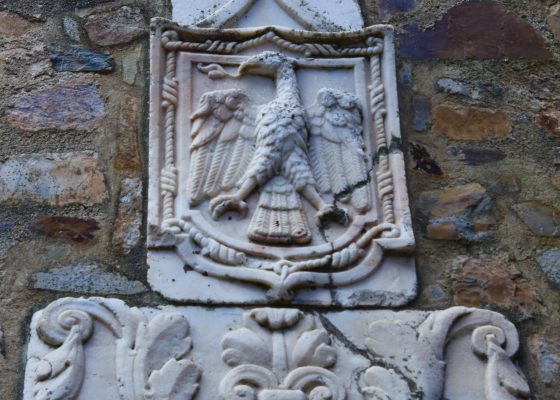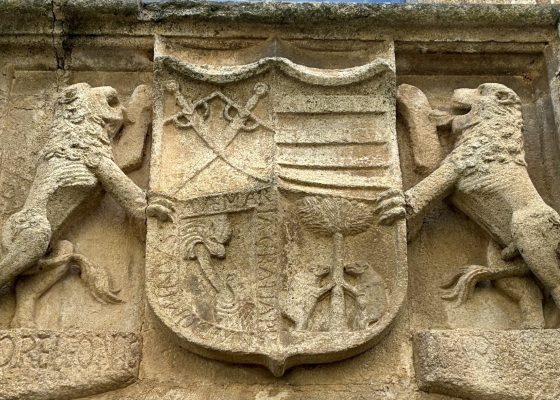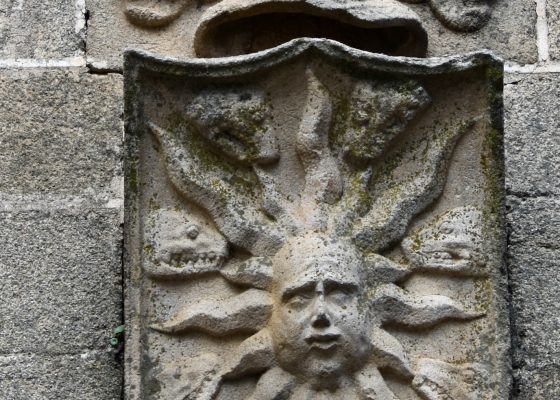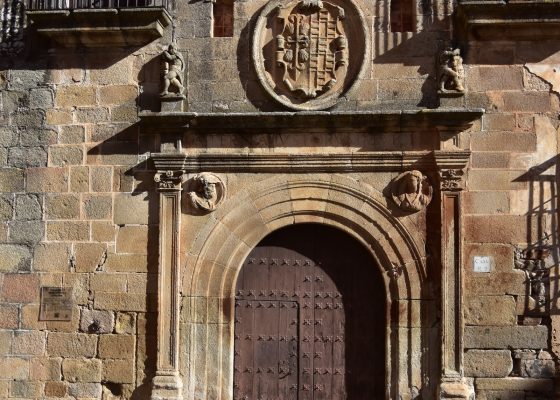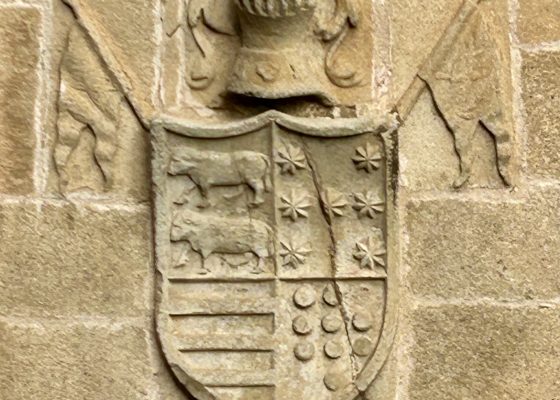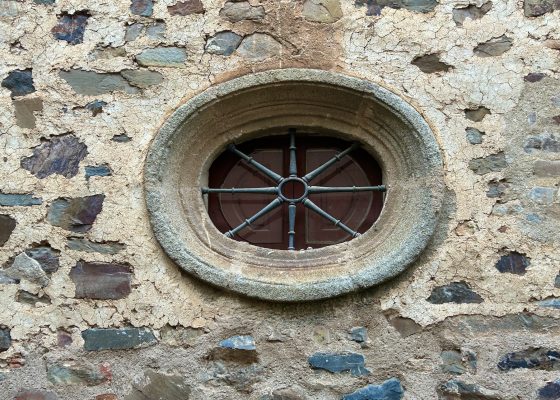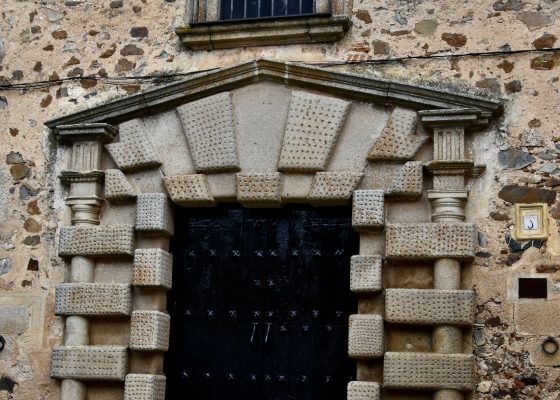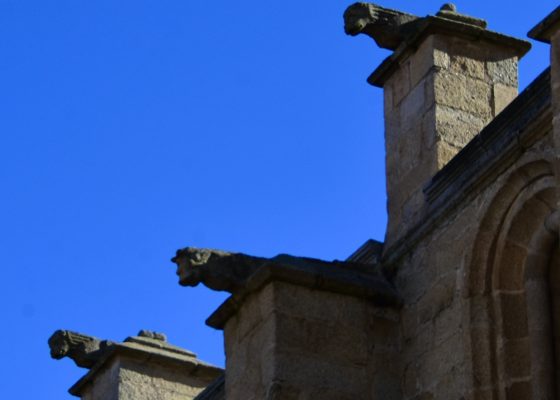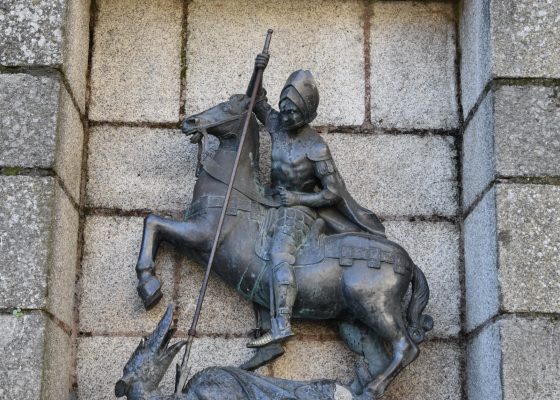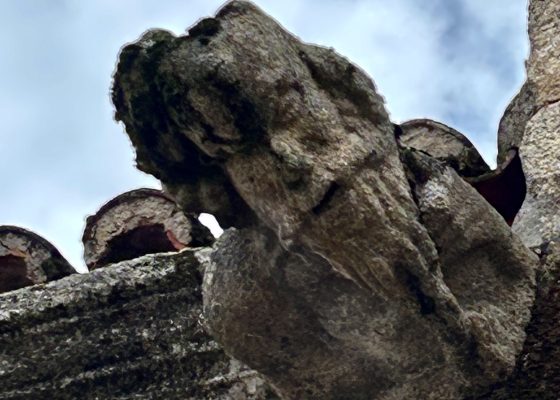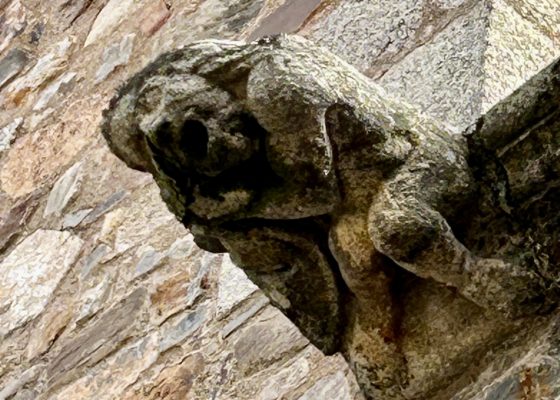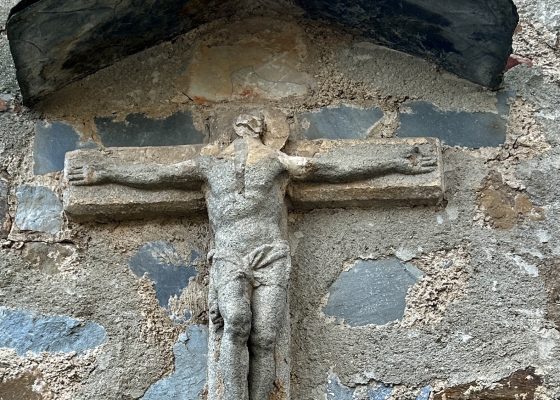Caceres – Extremadura’s Magical City
This is my fourth post from a recent SATW sponsored trip to the Extremadura area of Spain. In the first post I gave seven great reasons to visit the Extremadura. In the second I focused on the connection with ancient Rome to be found in the city of Merida and its environs. In the third I embarked on a day of discovery with Pepe Alba, learning the secrets to creating the world’s best cured ham, jamon iberico. In this post I’ll explore the many things to do in the ancient city of Caceres which is where we were based for much of the time in the Extremadura. It’s a UNESCO World Heritage Site for a good reason as we are about to find out.
History of Caceres

The history of Caceres goes back even before homo sapiens made it to Europe from Africa. In 1951 a small cave in what is now a park was discovered which had dozens of stencilled hand prints on the walls. Initially thought to be made by humans, recent more accurate scientific dating methods have determined that these hand prints in the Cave of Maltravieso are almost 67,000 years old which means they could only have been made by neanderthals. As such this is the oldest evidence of prehistoric art in the world. Further investigations by archaeologists have determined that the cave was occupied as long ago as 350,000 BCE. While you can’t go inside the cave you can see some of the artifacts from it in the Interpretation Centre run by the Caceres Museum.
The actual city of Caceres was founded by the Romans in 25 BCE and there are still remnants of the Roman city present today, most notably the Arco de Cristo, one of the four gates leading into the old city. Roman occupation lasted for about 400 years and was succeeded by the Visigoths who basically added nothing to it for the next four hundred years when the Arabs arrived from North Africa. They held it until 1229 when the Christians retook it for good. Most of the walls and many of the buildings inside the walls date from the late Arab period. There was also a significant Jewish population here until their expulsion in 1492.
After 1492 Caceres became quite wealthy from the many Extremadura families that were deeply involved in the exploitation of the new found riches of the New World. Both Cortez and Pizarro were from the Extremadura as were many lesser known conquistadors. The magic of Caceres is that virtually nothing has changed inside the walls since those times. Yes the buildings have been modernized inside, but from the outside you can easily convince yourself that you have been transported back in time some 500 years or more. It is this marvellous state of preservation that led to Caceres being inscribed as a UNESCO World Heritage site in 1986.
OK, now that we’ve got the background let’s start exploring Caceres. This is a map from the Walking Extremadura website which offers a very detailed walking tour of the city within the walls and if you do get to Caceres I urge you to download it. As you can see there are well over 50 points of interest.
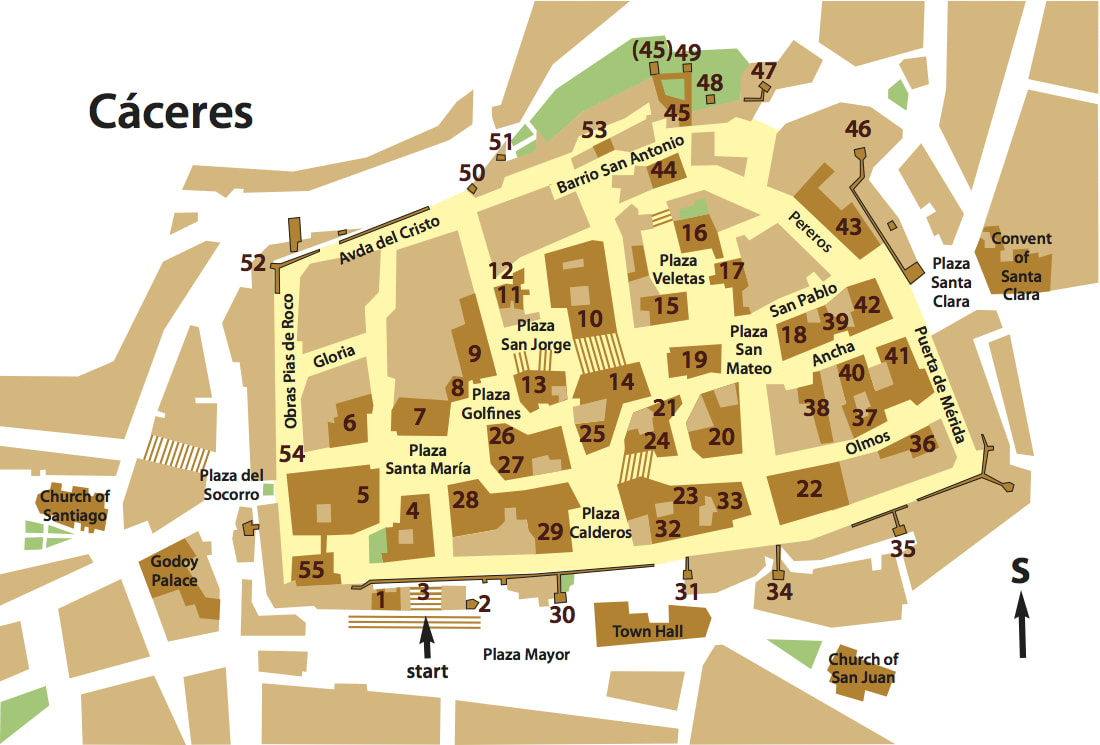
There are only a couple of places to stay within the walls of Caceres, one being the Parador de Caceres and the other the Relais & Chateaux Atrio which is tres chic with a three star Michelin restaurant. Our SATW group stayed in the NH Collection Caceres Palacio de Oquendo which you can guess from the name is in an old palace that abuts the city walls at about location #31 on the map above. It’s only a few minutes walk to the main gate into the old city and has a great bar and terrific morning buffet. It’s also close to the many shops and restaurants that line the side of the Plaza Mayor which is itself a major attraction in Caceres.
Before entering the old city there is one statue that bears seeing just outside the Church of San Juan. I have seen umpteen sites on the web describing it as two figures from the Spanish Inquisition and even some comparing it to the Ku Klux Klan. Nothing could be further from the truth. These are in fact two members of a Caceres brotherhood of which there are currently fifteen of these fraternal groups that are known for their colourful costumes and their monumental processions during the Holy Week of Easter. Some were founded over 500 years ago and although Spain is nowhere near as solidly Catholic as it once was these groups continue to flourish in Caceres with some now including women as members.
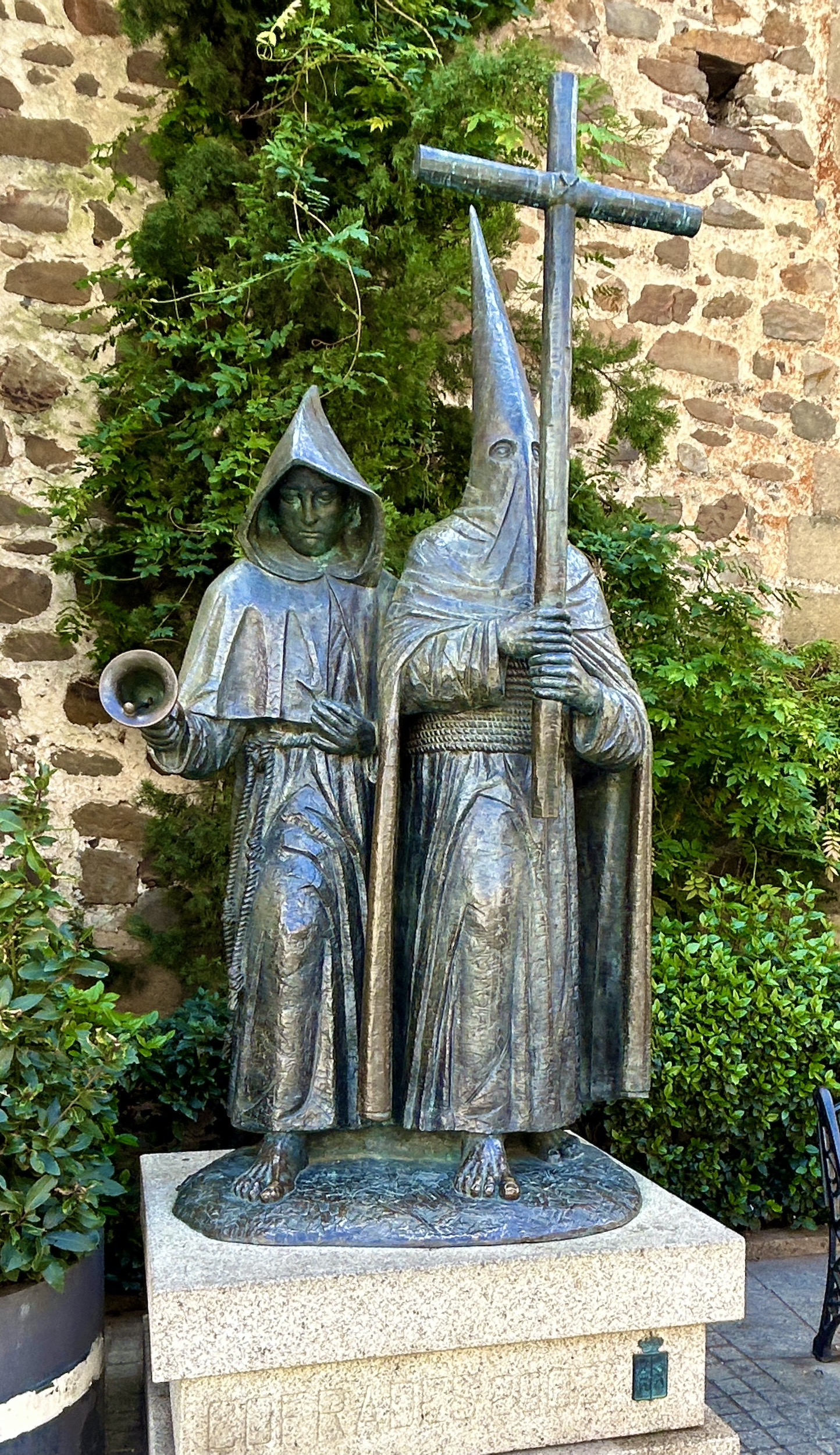
You can get a look at these brotherhood costumes in a small exhibit beside the Church of San Francisco.
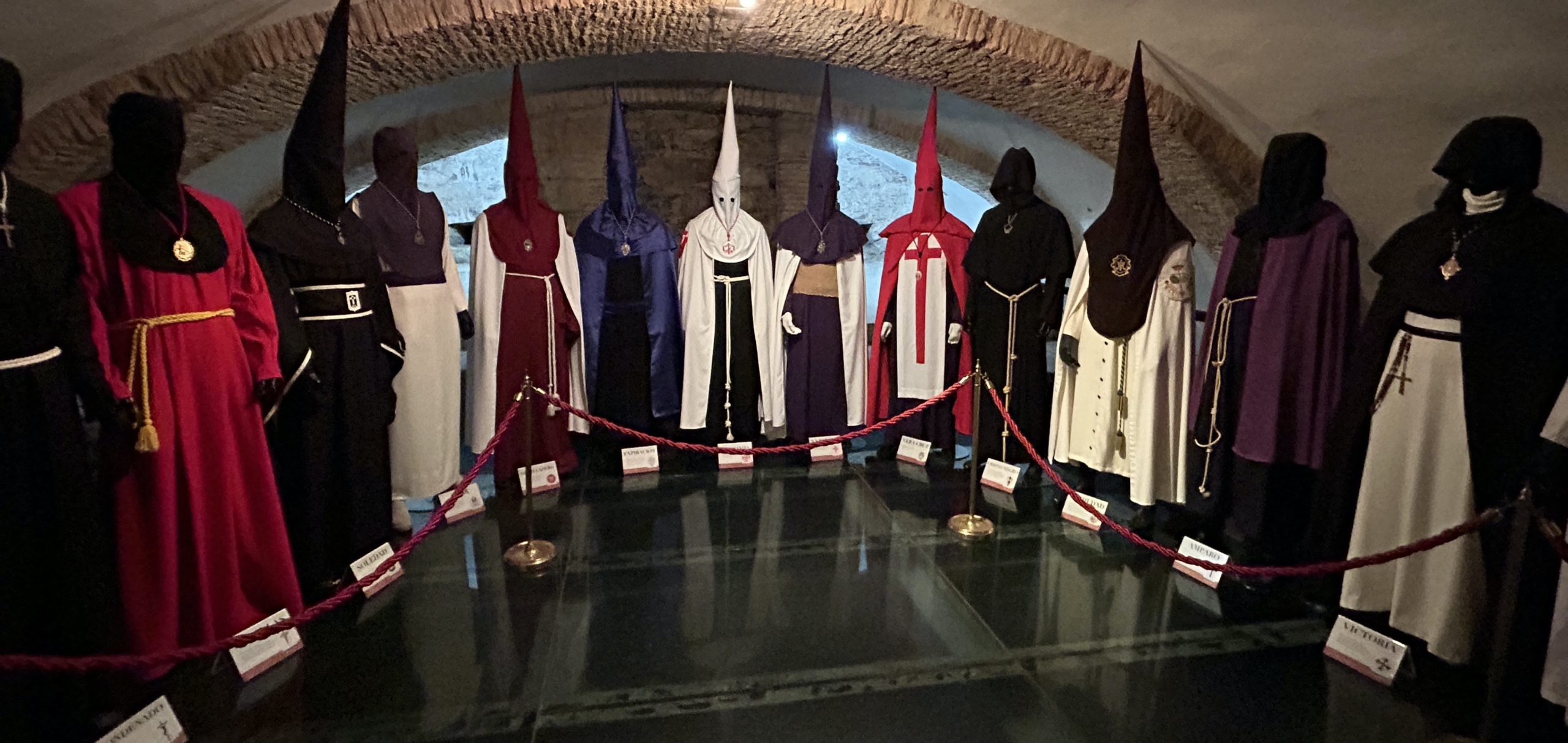
The medieval city of Caceres is famous for its walls, towers, palaces and churches and most people start their visit by entering through the Estrella Arch with is the main entry point to the walled city. If you are a Game of Thrones fan, as I most definitely am, you might recognize this portal from an episode in the final season of the show where it doubled as an entrance to King’s Landing. Currently Caceres is one of the major shooting sites for House of the Dragon the prequel to GoT.
Right next to the Estrella Arch is the Tower of Bujaco, an Arab construction dating from the 12th century which is one the few places in Caceres that you can actually get on to the remnants of the city walls.
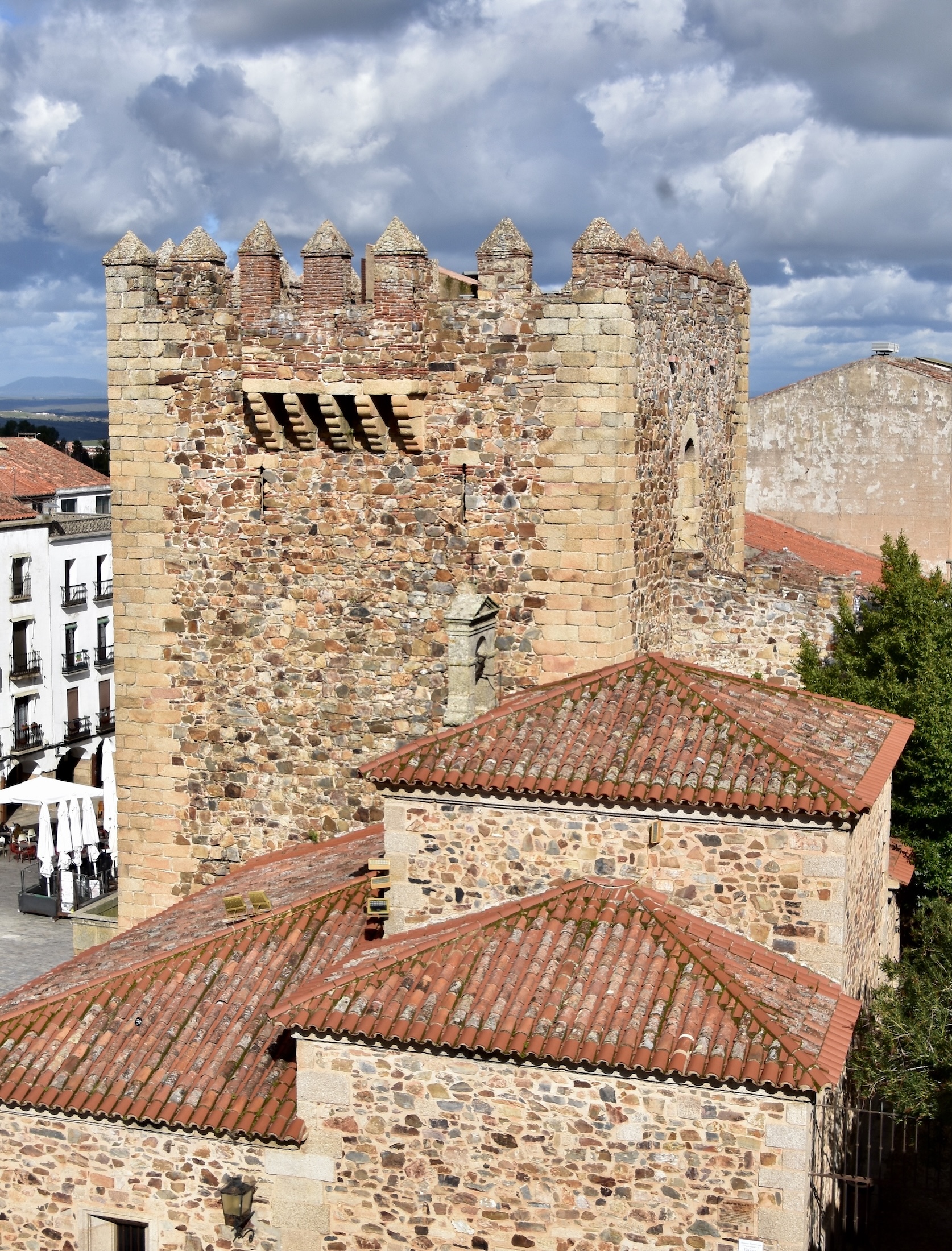
From the Tower of Bujaco you get a great view of another of the city’s most famous buildings, the Toledo-Moctezuma Palace with its distinct white dome. You might wonder why part of its name is the same as the last emperor of the Aztec Empire, Moctezuma II. As I mentioned earlier, Caceres was a city which many of the Spanish conquistadores called home and one of these was Juan Cano Saavedra, a confederate of Hernan Cortes in the destruction of the Aztecs. He married a daughter of Moctezuma, Isabel and she bore him six children in this palace. It is not open to the public so you have to satisfy yourself with the view from the Tower of Bucajo.
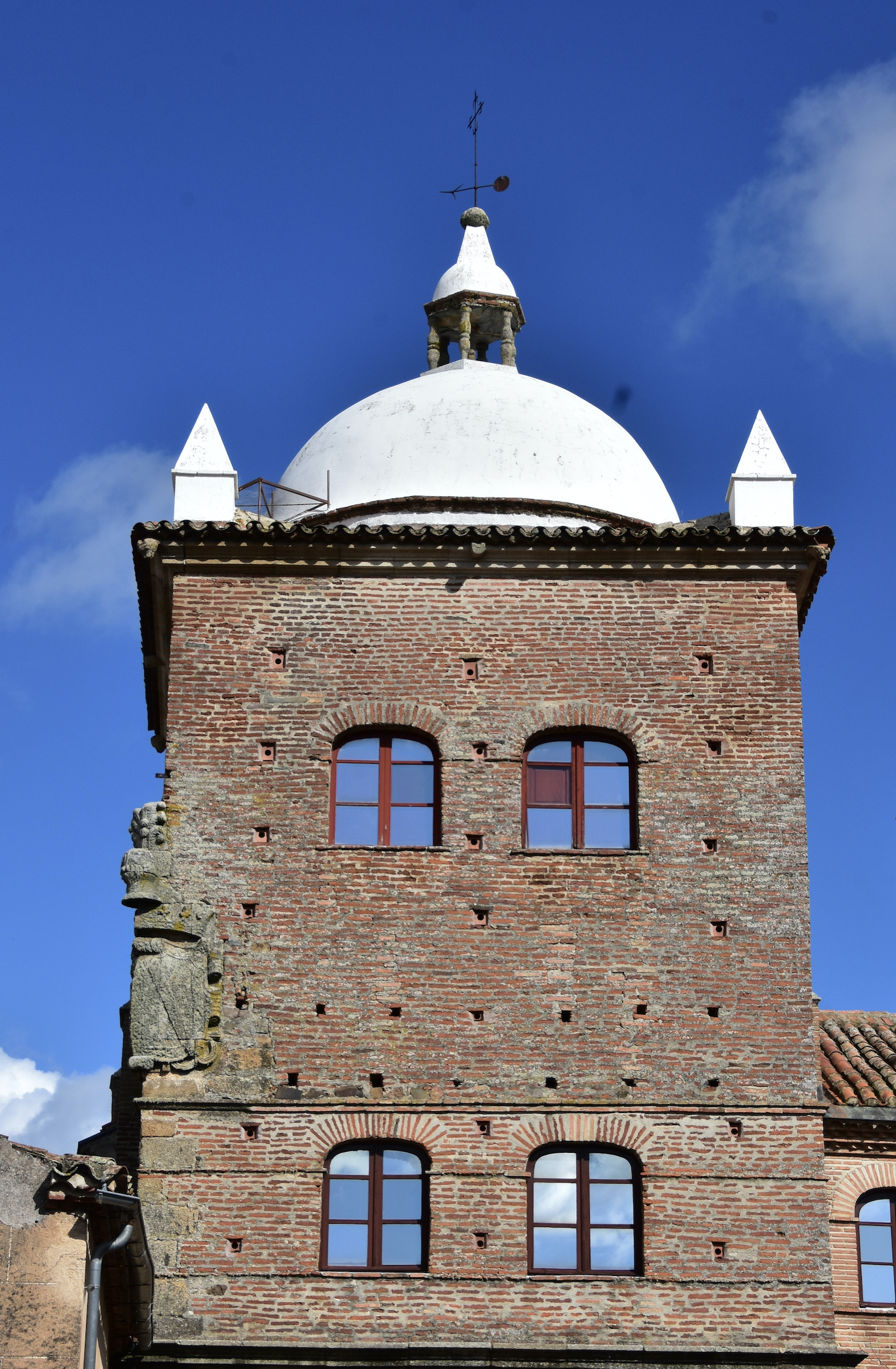
Most visitors to Italy make it a point of seeing the famous towers built during the Renaissance when it was comprised of a dozen or more city states that were constantly at war. Within those city states there were families engaged in constant feuds such as the Ghibellines and Guelphs and they built towers as adjuncts to their palaces. No city in Italy is more well known for these towers than San Gimignano where there are a dozen of them.
Well guess what? Caceres has over thirty towers, built largely for the same reasons as those in Italy, family feuds. So why hasn’t this made Caceres as famous as San Gimignano? There is one simple reason, all but one of these towers were figuratively castrated. After the death of Henry IV of Castille in 1475 two women fought a brief war over the throne with the dead king’s half-sister Isabella triumphing over his daughter Joanna. Unfortunately for the notable families of Caceres all but one, Don Diego de Ovando backed Joanna. Taking revenge, Isabella ordered the tops of every tower but Don Diego’s to be removed. So today as you come upon one tower after another, only this one, the Tower of the Storks has its original battlements.
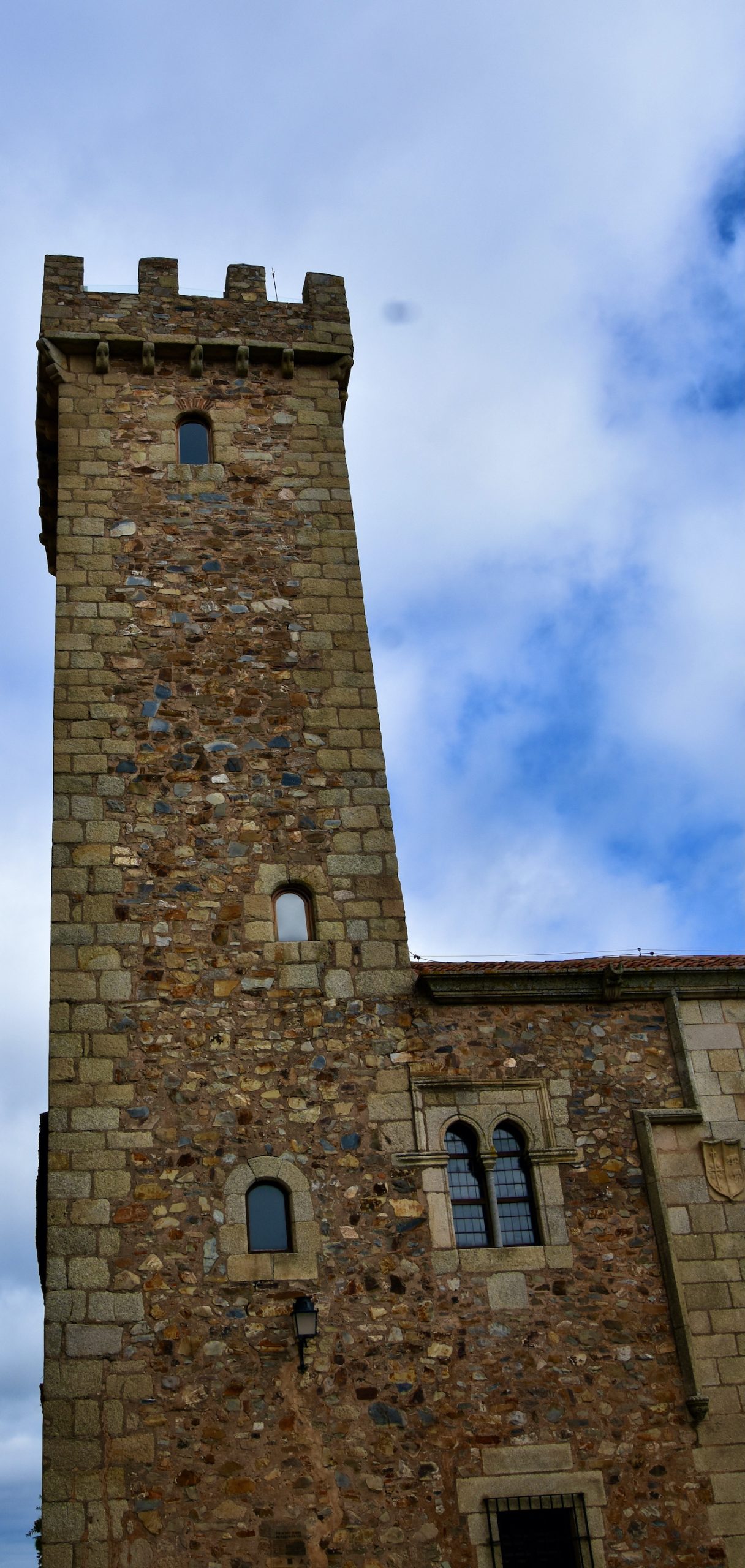
Here are a couple of the losers in the War of Castilian Succession.
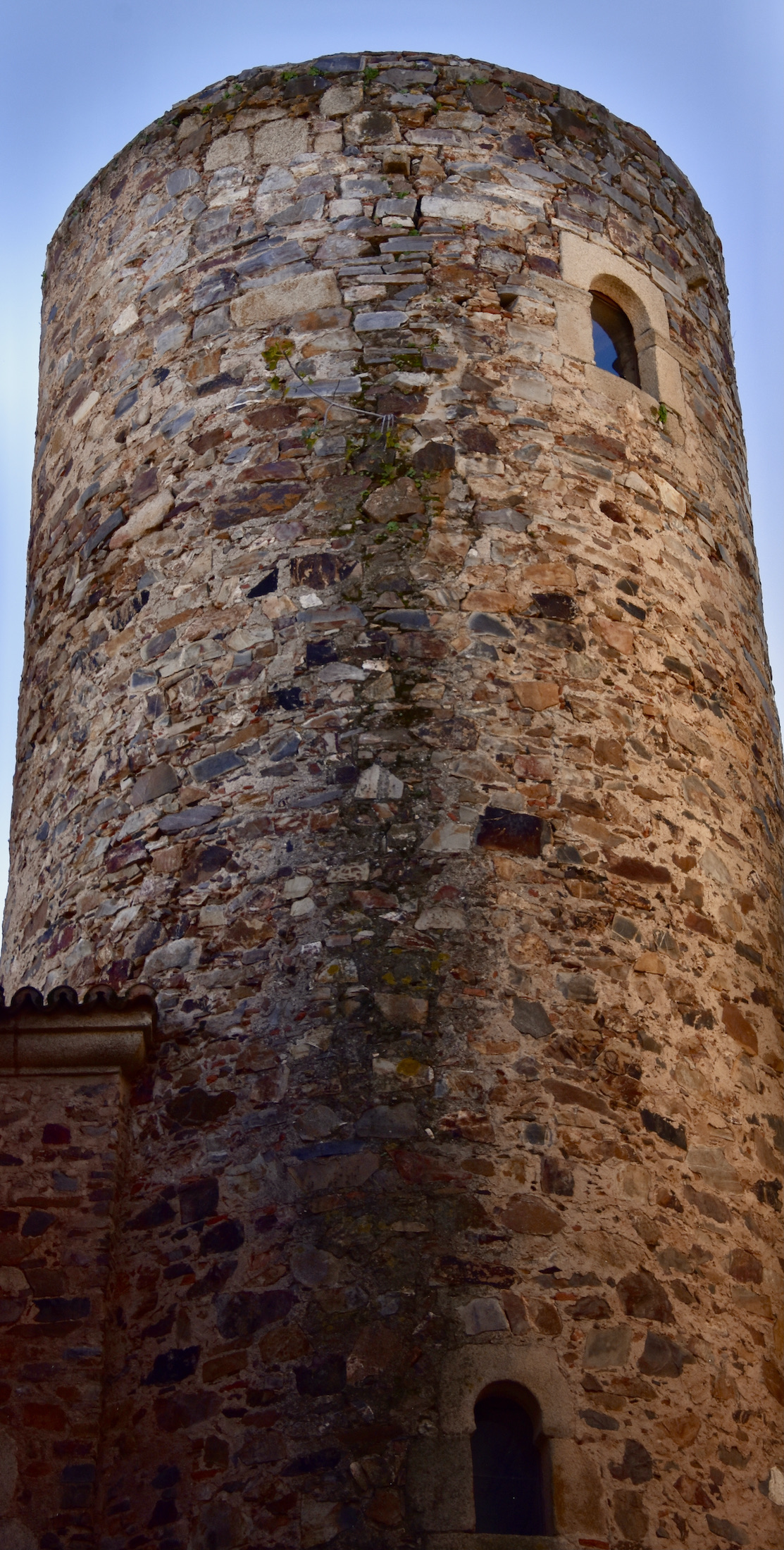
and
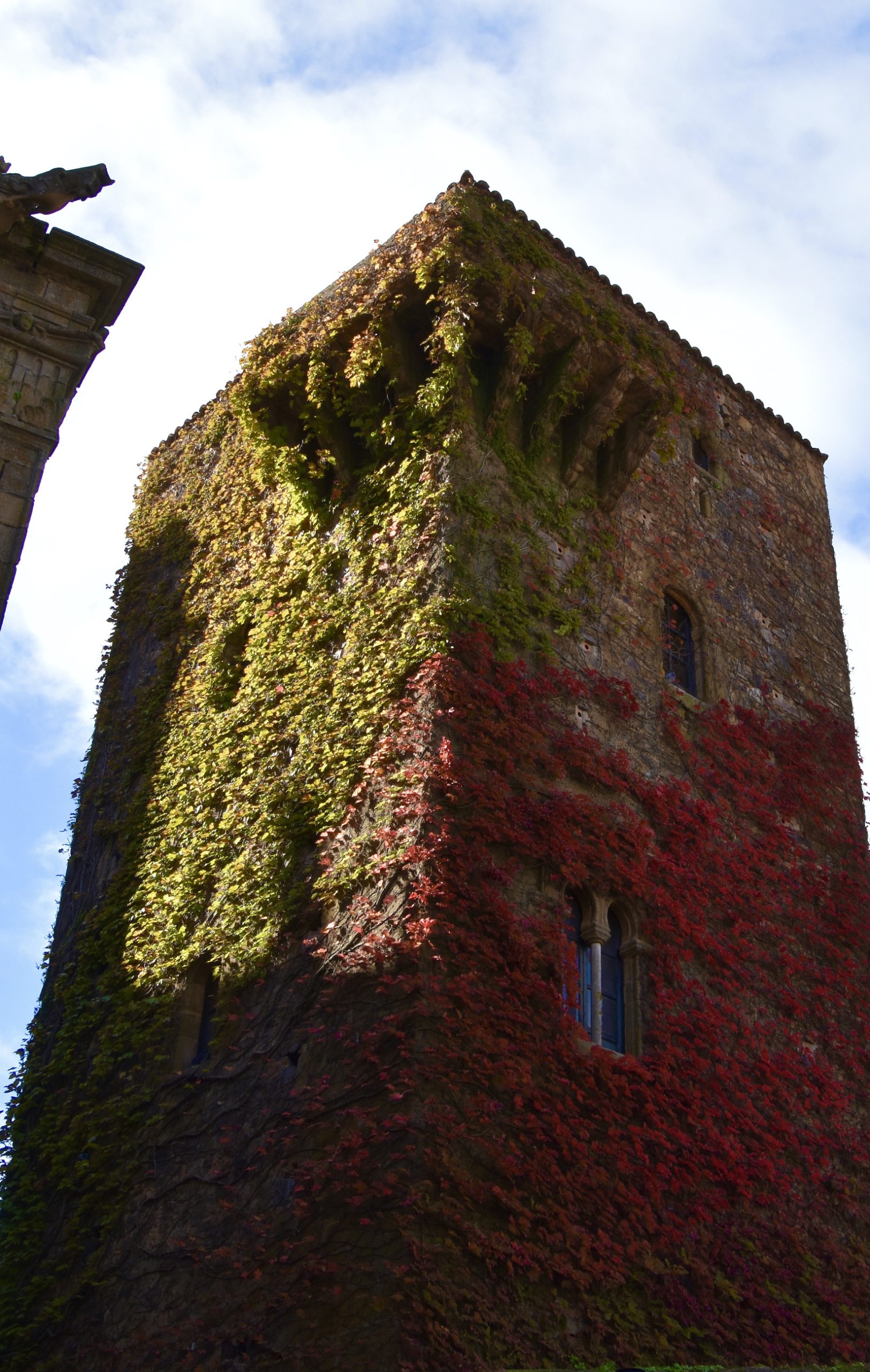
One of the notable features of these towers are the murder holes from which defenders could shoot arrows, throw rocks or the proverbial boiling oil down at attackers.
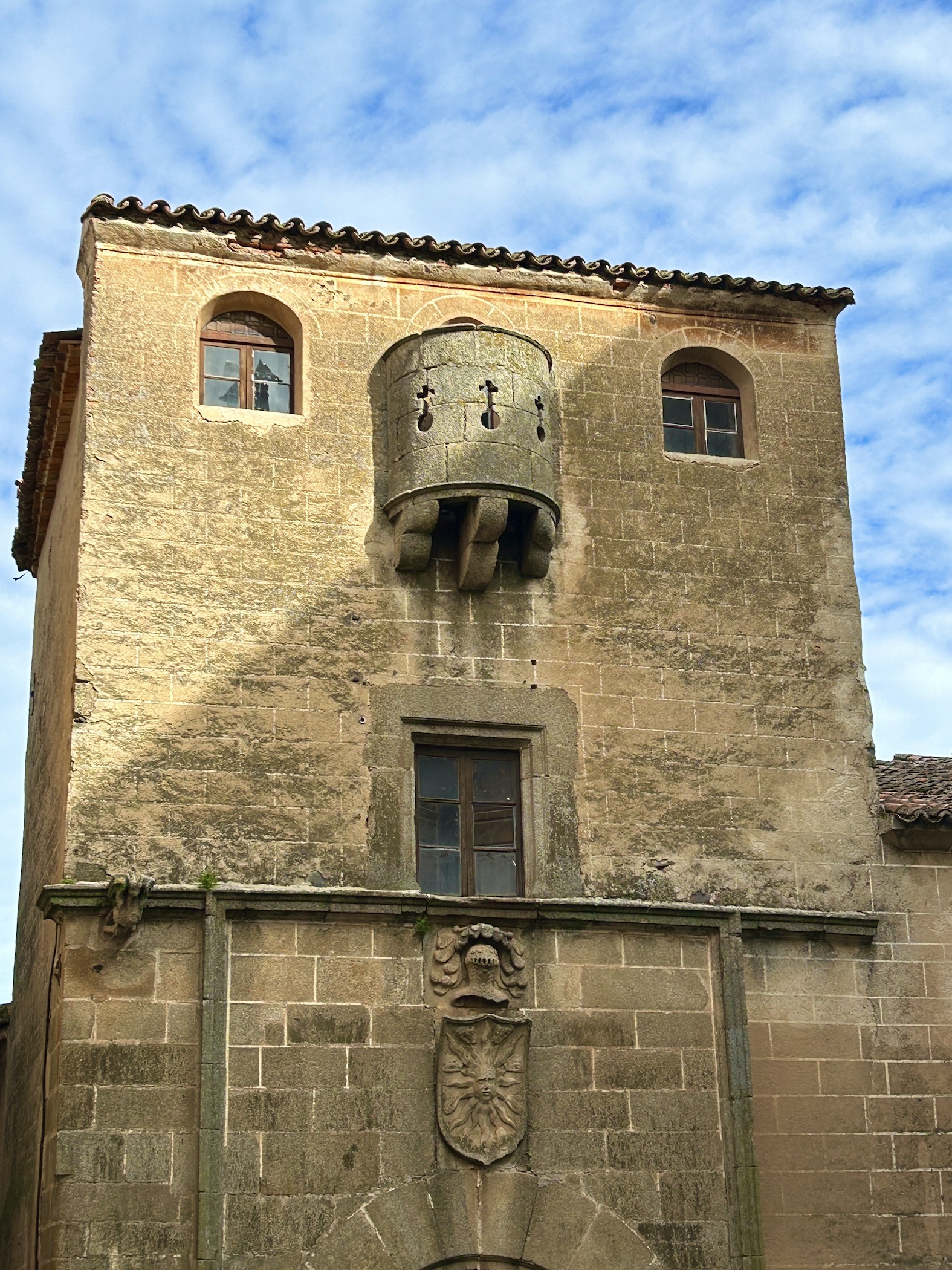
Within the walls of Caceres you’ll find a number of churches that are worth visiting both for what’s inside and in a couple of cases to see the view from their steeples. Let’s start with the most recognizable one that features in almost every photo of the city, the Jesuit church of San Francisco. It was built in the 18th century which explains its completely different appearance from the other older churches which all have stone exteriors while San Francisco is covered in white plaster. Behind San Francisco you can see the church of San Mateo which is much older and built on top of the primary mosque of Caceres. This photo was taken from the tower of the Church of Santa Maria.
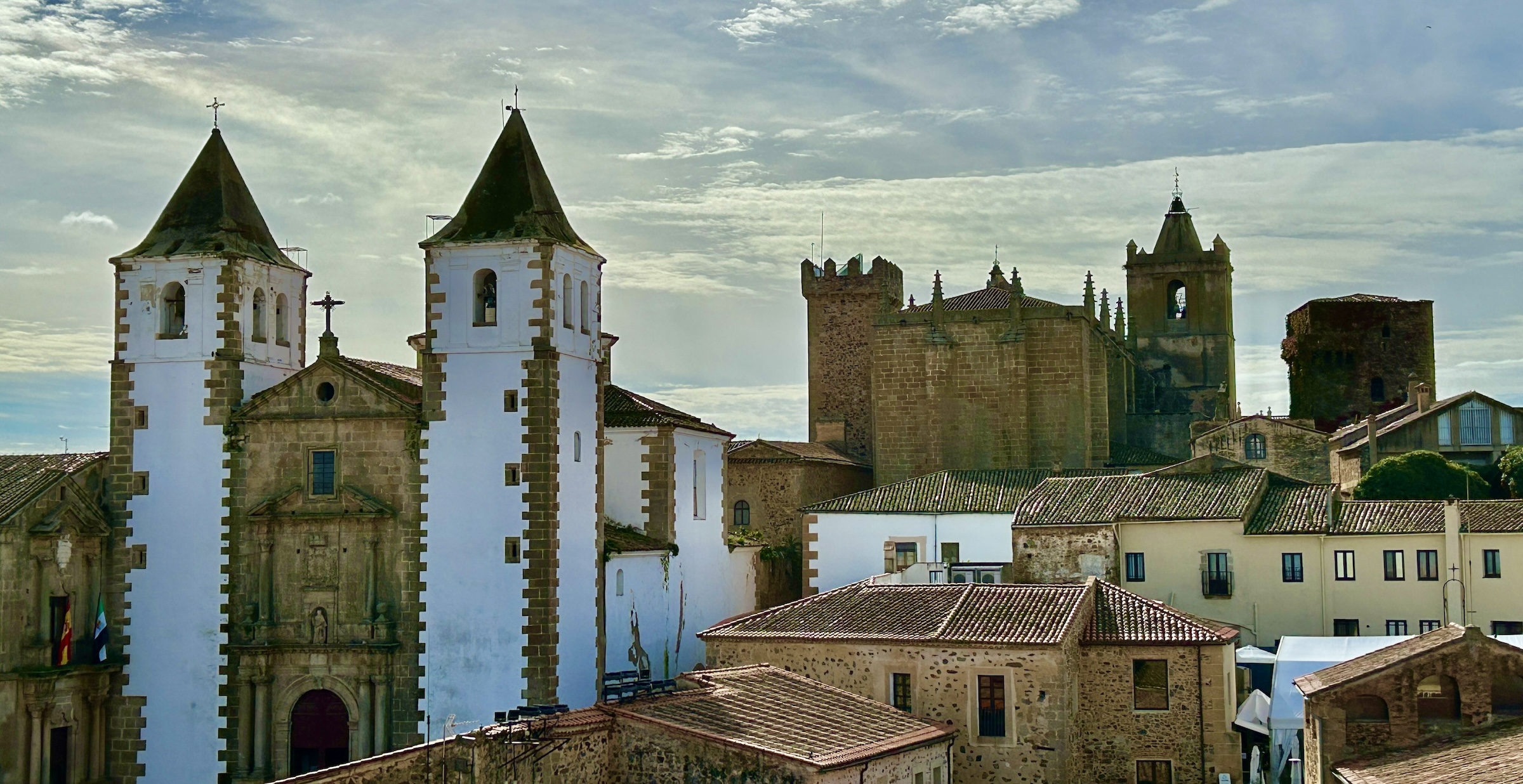
The interior features this amazing golden altar which unusually has a painting as its centre piece. This depicts the Miracle of the Crab, a story associated with St. Francis Xavier the founder of the Jesuits. While encountering a storm at sea that threatened his ship St. Francis threw his cross into the waters, which immediately became calm. Upon reaching land St. Francis was handed back his cross by a dutiful crab.
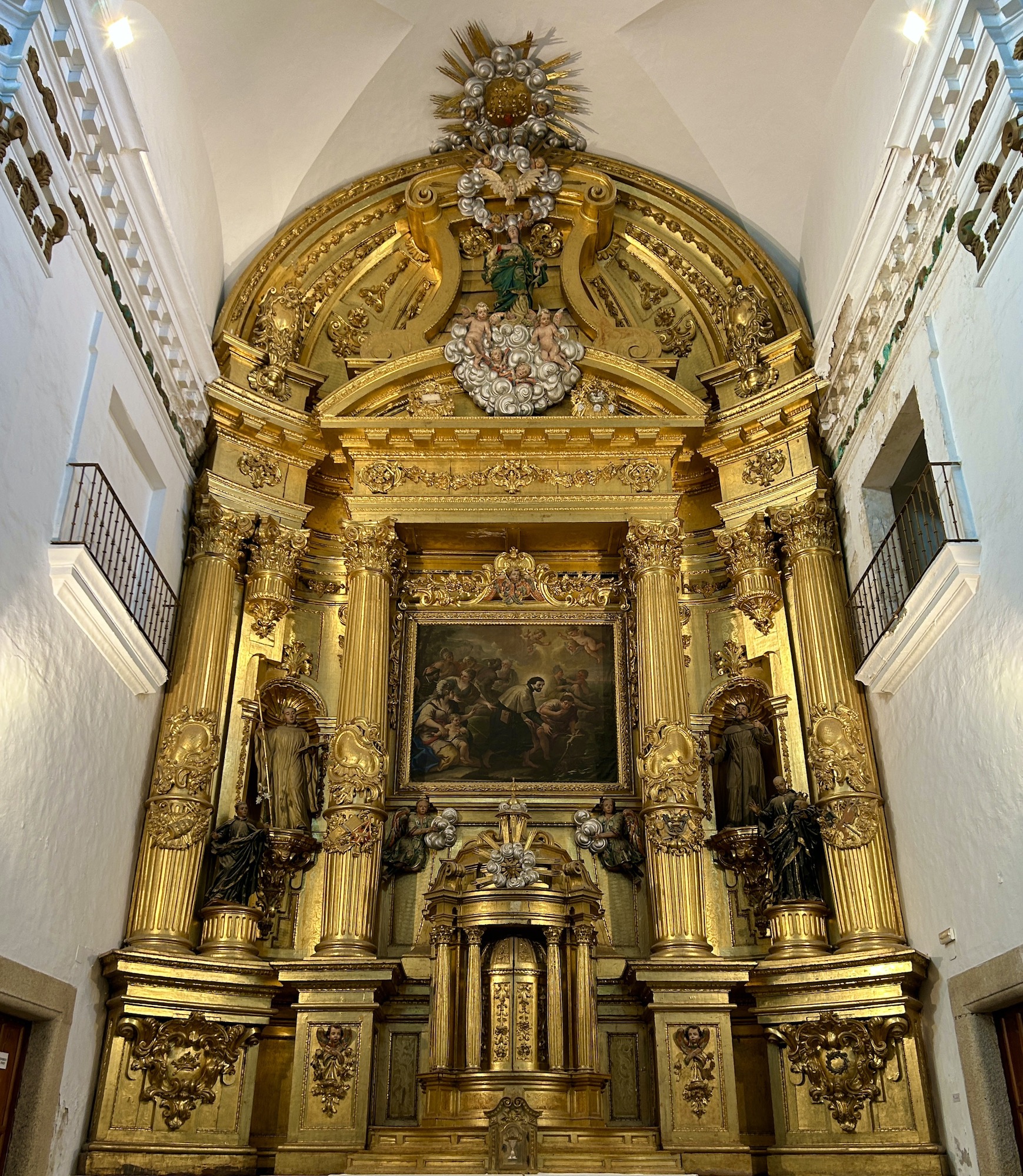
You definitely need to climb to the towers for the view of Caceres and the Extremadura countryside. On the way up you get this view from the balcony.
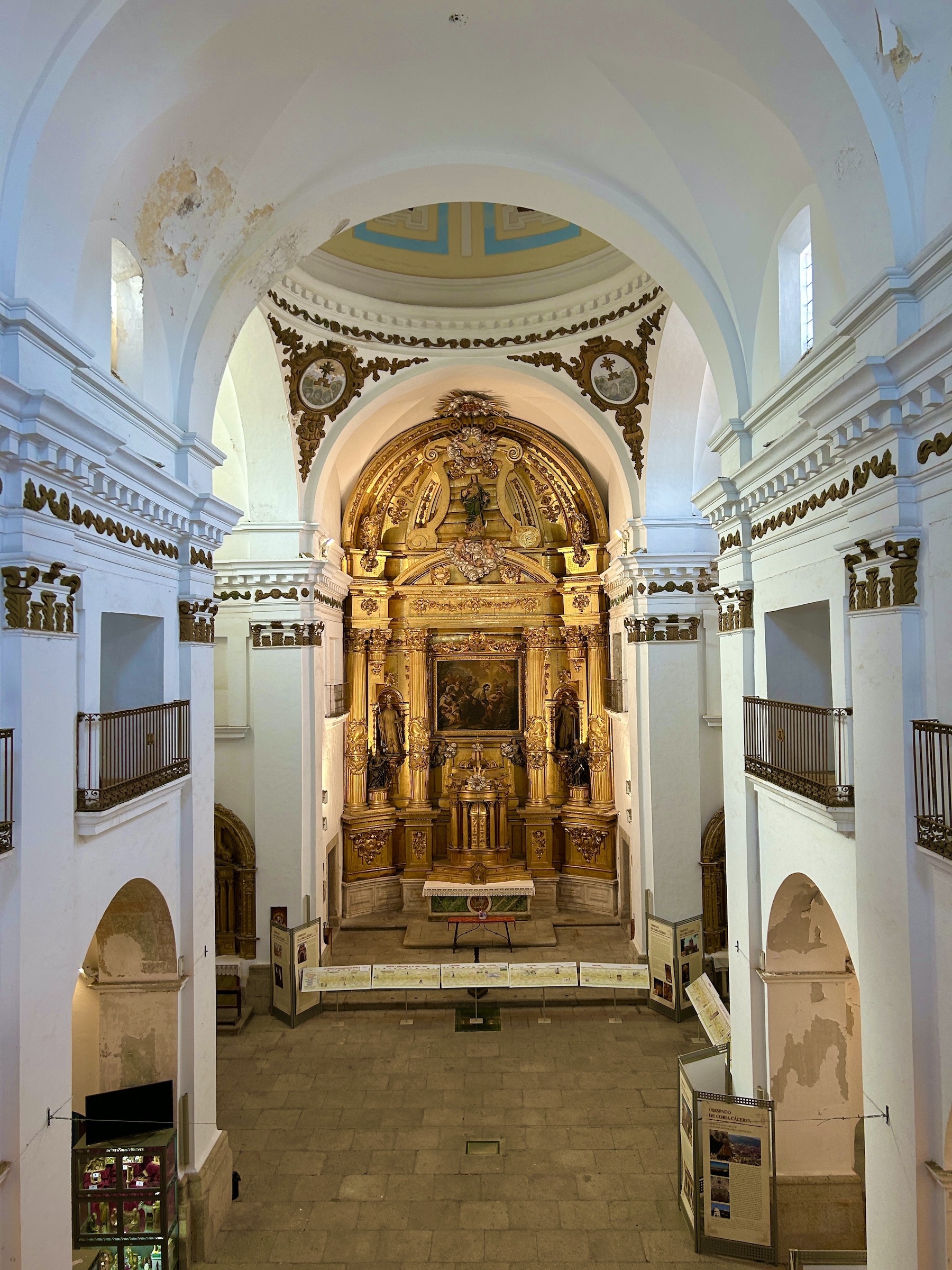
And this is the view of the city from one of the towers. That’s the Church of Santa Maria to the left which is where we are headed next.
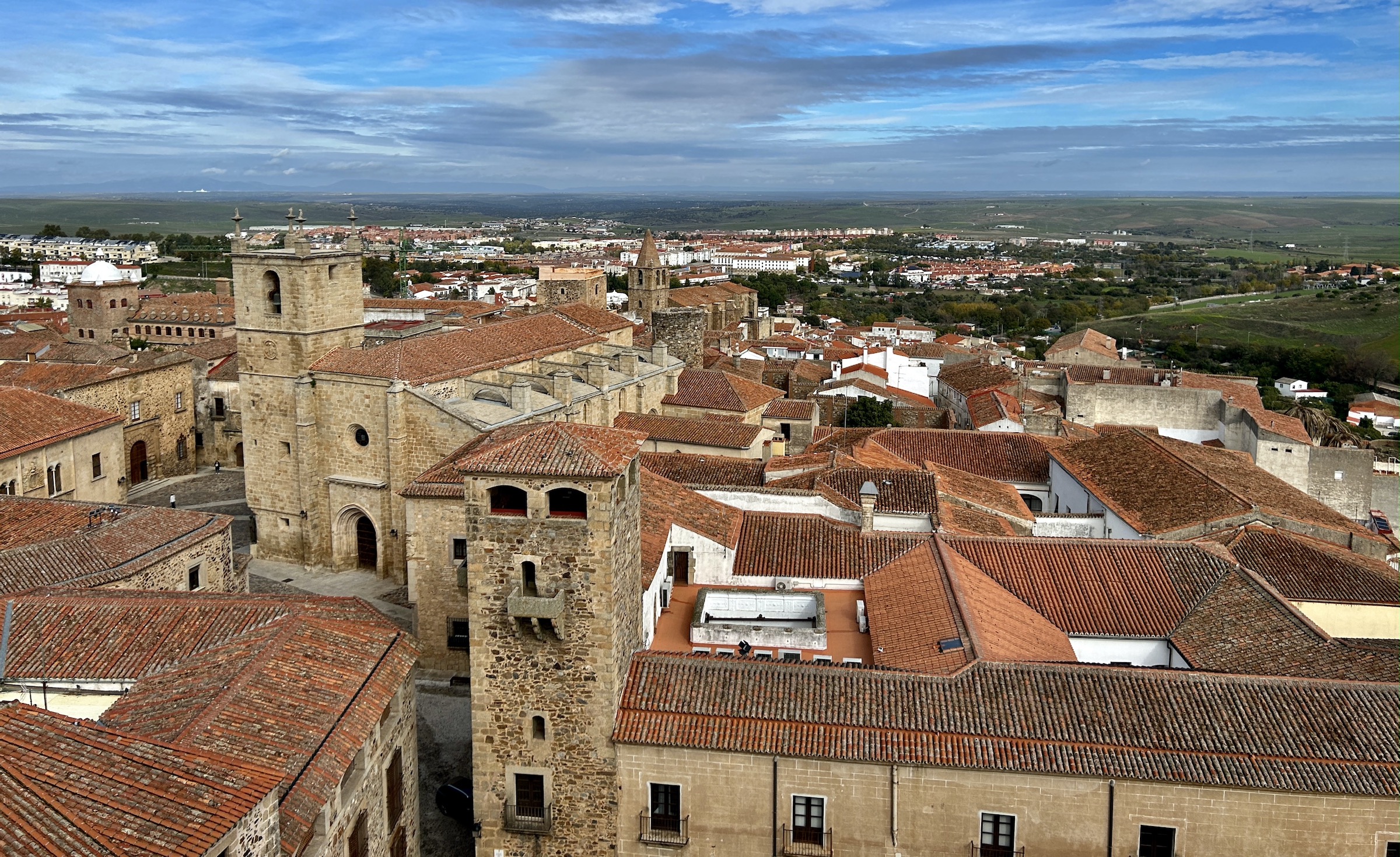
And this is the view looking north.
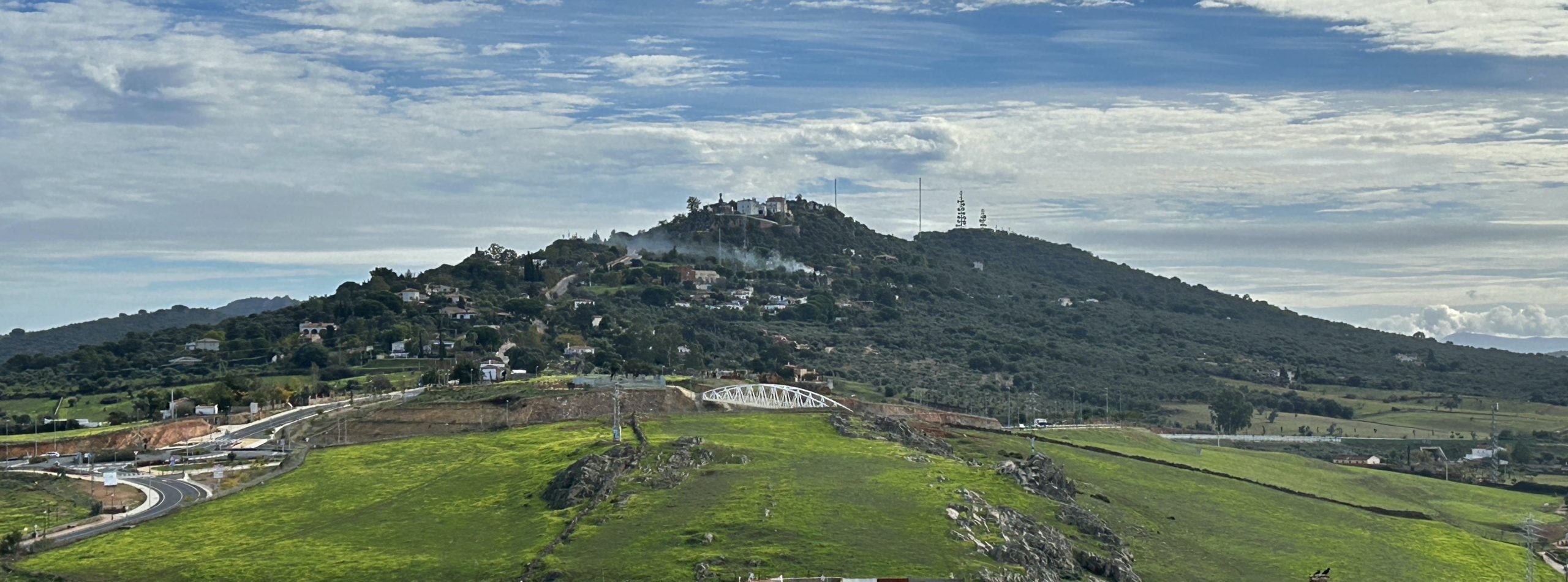
The Church of Santa Maria is actually a co-cathedral and not a full fledged one, but that doesn’t diminish its importance to the people of Caceres. Its origins date back to the 13th century, but the structure today dates mostly from the 15th and 16th centuries.
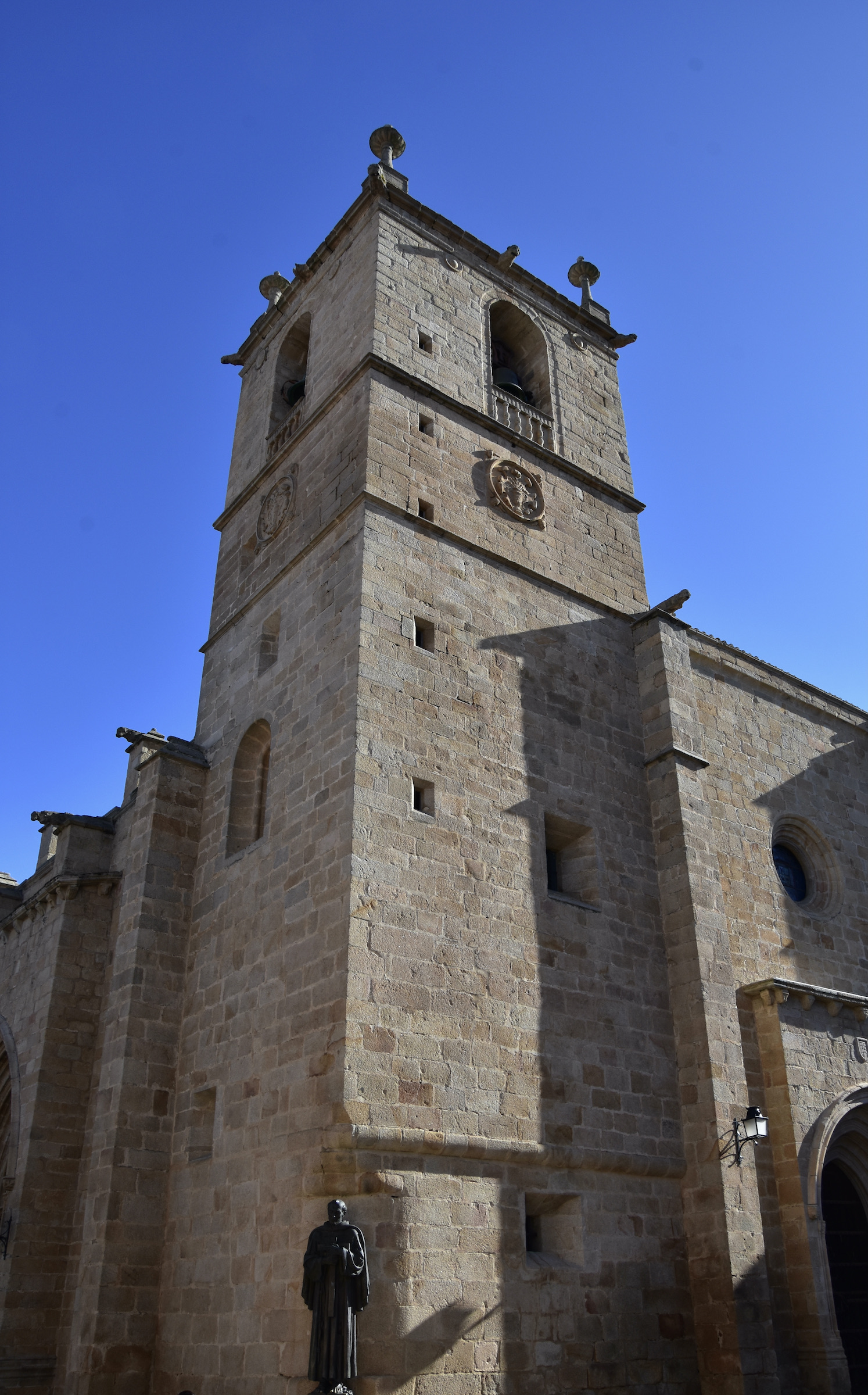
Outside is this statue of San Pedro de Alcantara who is the patron saint of the Extremadura and the country of Brazil.
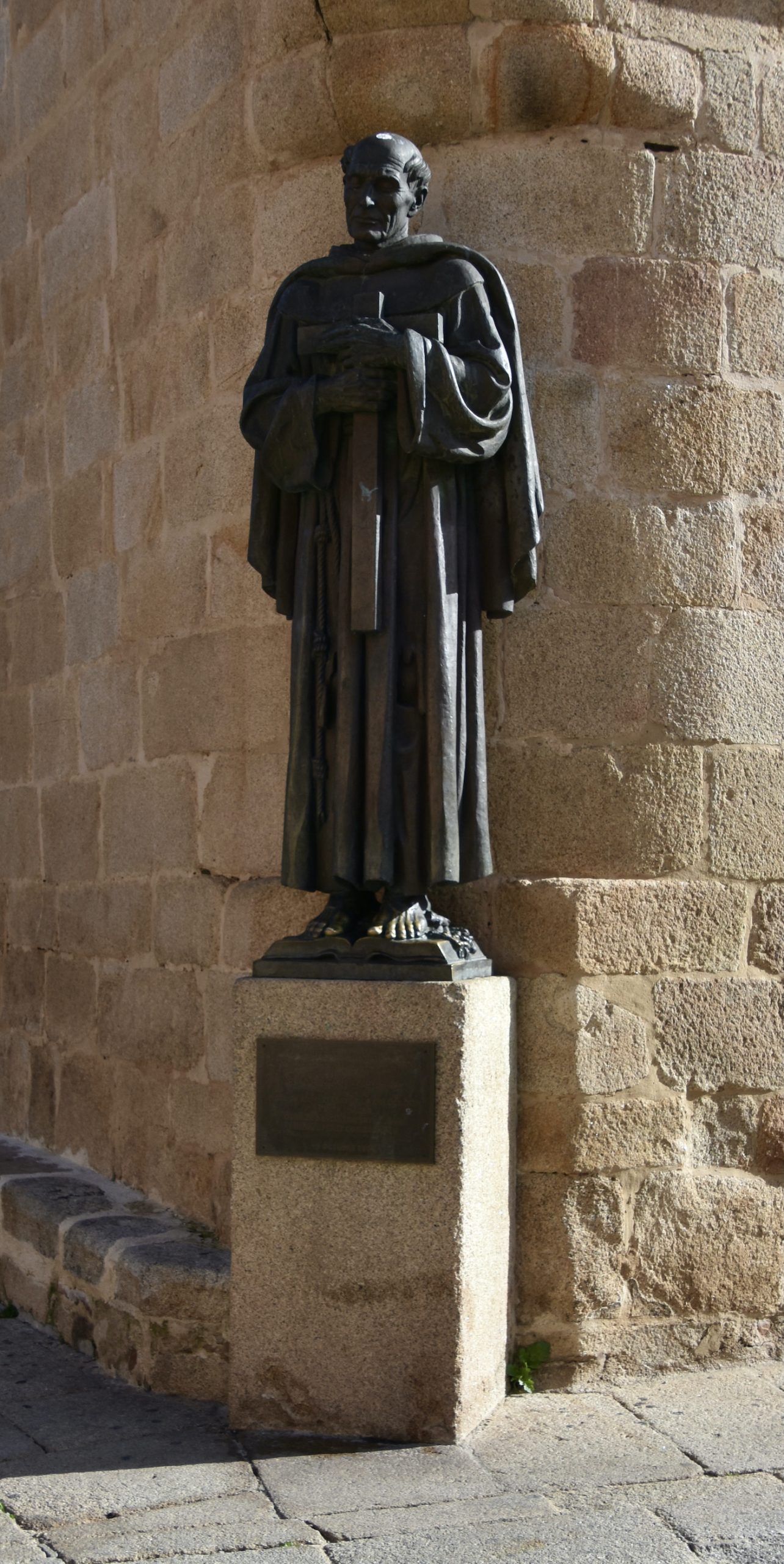
The interior is most noted for this 13th century wooden crucifixion known as the Black Jesus of Caceres. Every Holy Wednesday the brotherhood of Cristo Negro takes the statue on a procession through Caceres starting at midnight. The brothers are dressed in black with their faces covered and they proceed in silence carrying torches. It is an event that is hundreds of years old and today has become a major tourist attraction, albeit a solemn one. Follow this You Tube link for a video of the procession.
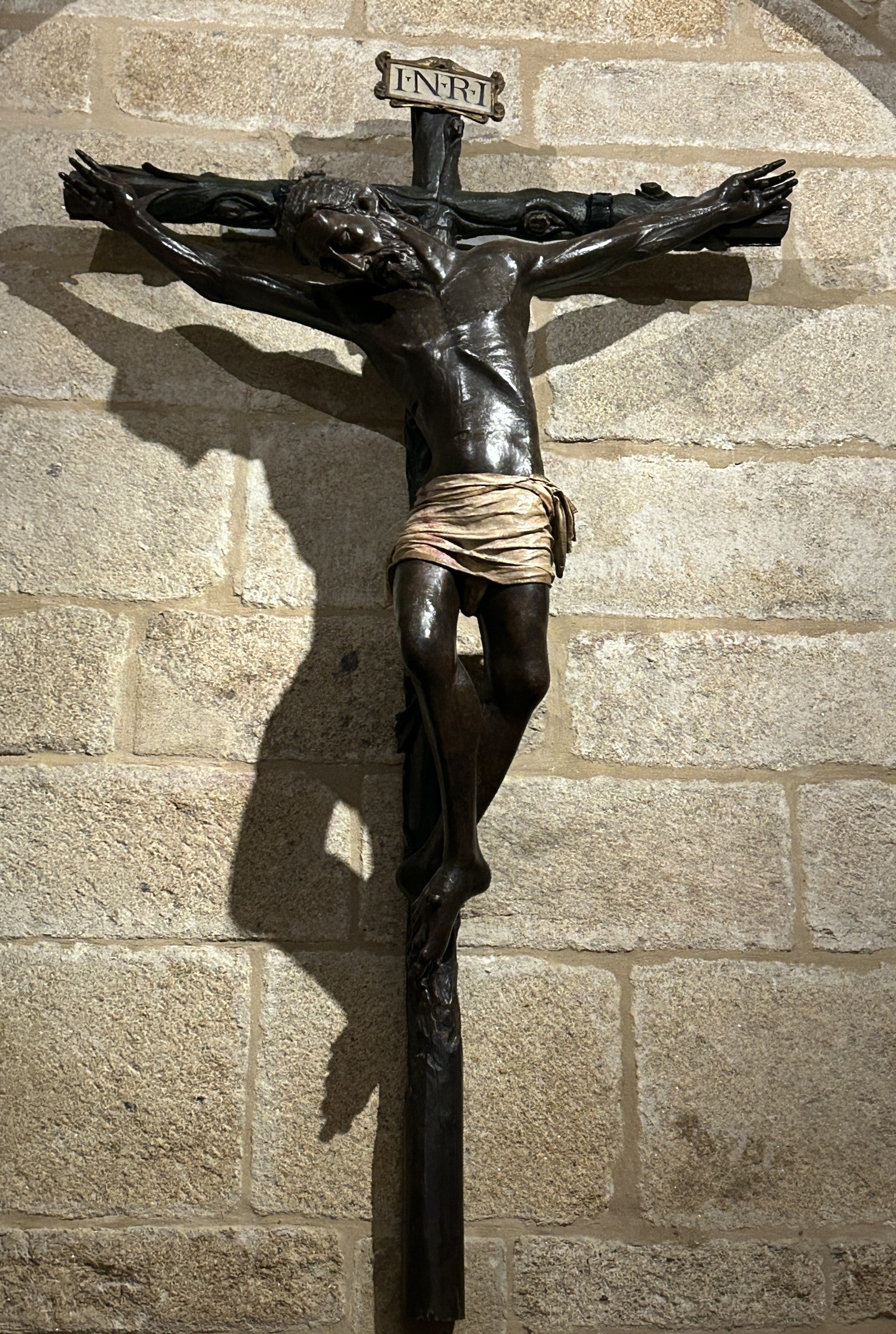
Although the view from the tower is not as compelling as that from San Francisco it’s still worth doing if just to get a photo of this marvellous stone staircase.
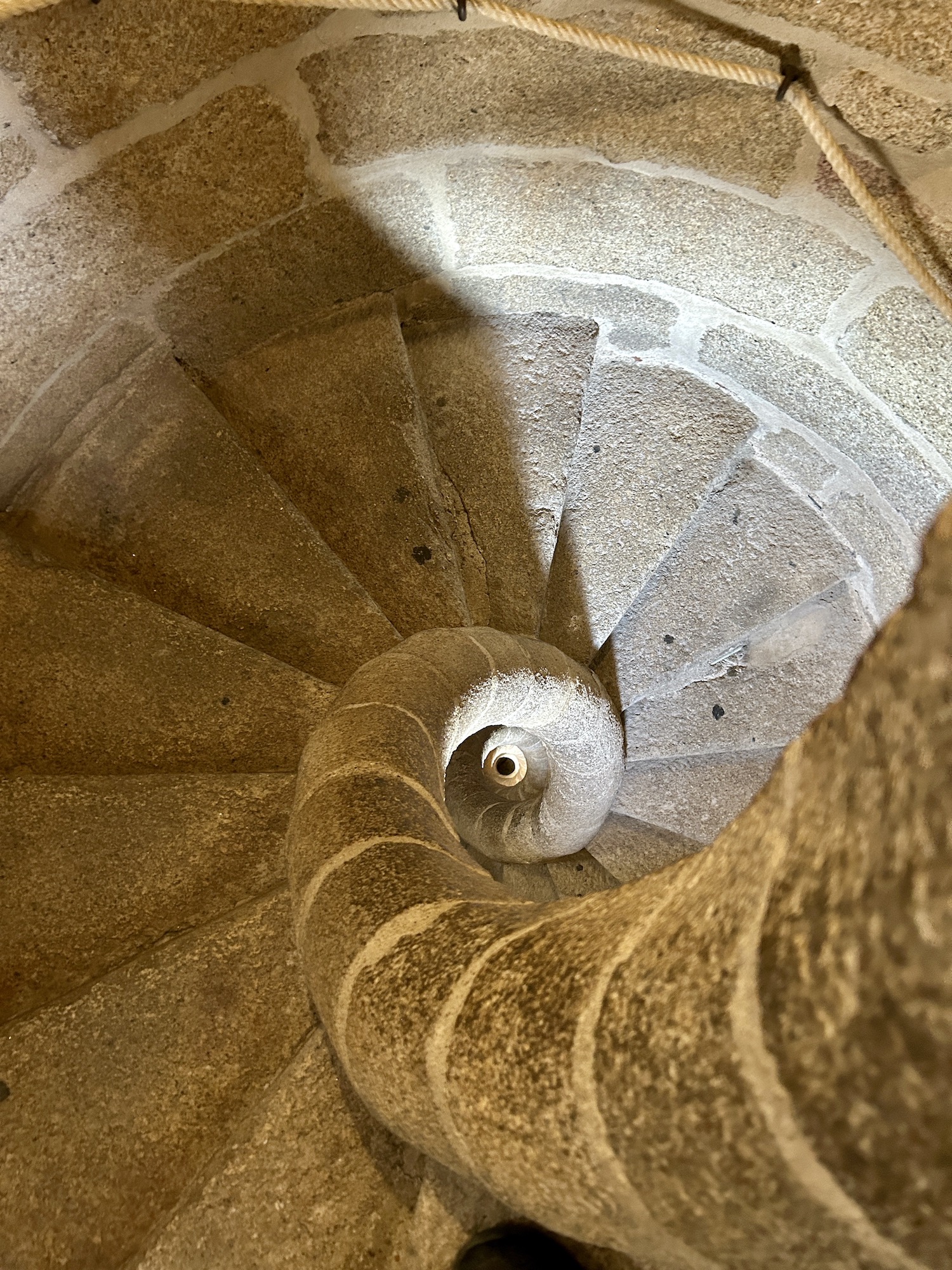
Next I’m going to focus on specific aspects of Caceres that are much smaller than the walls, towers and churches starting with the escutcheons or what most of us would call coats-of-arms. There are supposedly over 1,000 of these on the sides of buildings in the city and you could spend an entire day just seeking these out and photographing them. But there’s a lot more than just escutcheons to photograph as I hope this gallery shows. Double click to open and double click again to increase to full size.
- Eagle Coat of Arms
- Two Lions Coat of Arms
- Sun Coat of Arms
- Coat of Arms over an Ancient Door
- Coat of Arms with Pennants
- Round Window
- Fortified Door
- Gargoyles on Santa Maria Cathedral
- St. George and the Dragon
- Unusual Drain Pipe
- Another Drainpipe
- Decapitated Crucifixion
Lest you think nothing of importance has happened in Caceres for the last couple of hundred years I’ll end this post in front of this building. It was in here in 1936 that General Francisco Franco was declared head of the Nationalists who initiated and won the Spanish Civil War. He ruled Spain with an iron fist for almost forty years in what was, in effect, a fascist dictatorship that survived the downfall of Hitler and Mussolini.
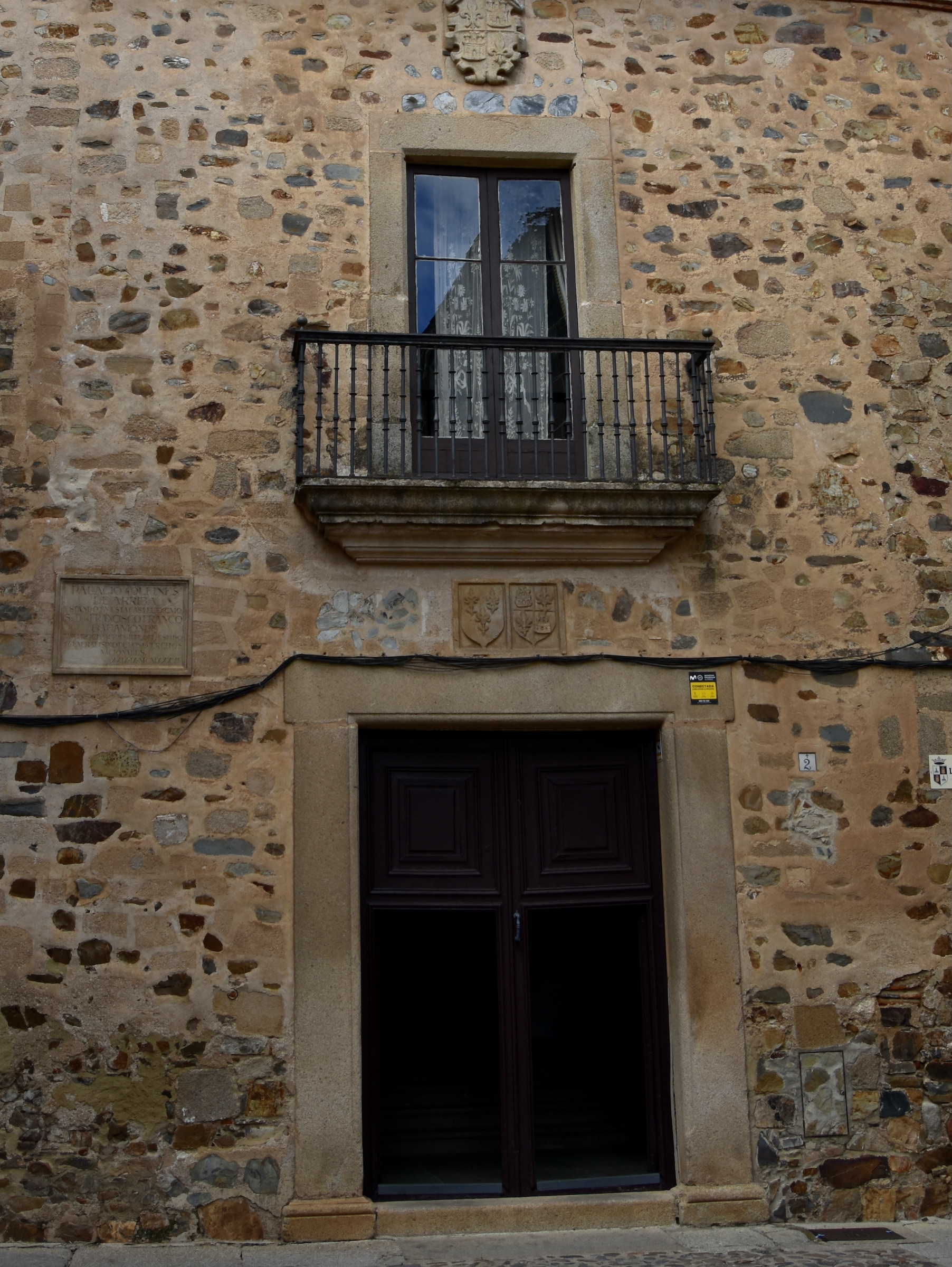
There is much more I could write about Caceres, but I think I’ve touched on enough of the highlights to convince anyone that this is a must visit destination in Spain. In my last post from the Extremadura we’ll leave the cities and venture into the magnificent Monfrague National Park.


